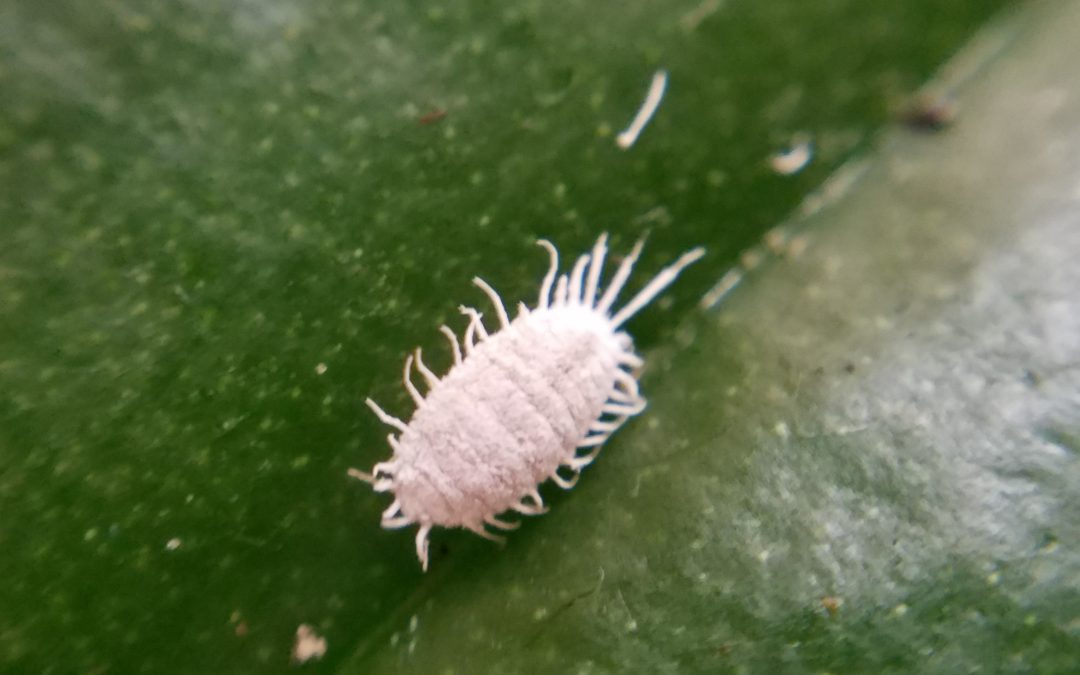
by Evan Anderson | Jun 24, 2021
There are lots of plant pests out there, and it can take a trained eye to tell which one is doing damage. Many of the insect pests that feed on crops and ornamentals have piercing-sucking mouthparts. These insects do not chew on leaves and leave holes behind; instead, they have a long stylus-like mouthpart they use like a straw to suck out plant juices. Over time this can weaken plants, cause irregular growth as damage builds up on new sprouts, introduce diseases to their hosts, and even cause mold to grow on leaves.
Because they drink so much fluid for their meals, many piercing-sucking insects exude a sugary liquid called honeydew. This liquid drops onto stems and leaves below which can leave them shiny and sticky. Eventually, the coating will grow a light greyish coating of sooty mold, which doesn’t do much harm to the plants itself but is a good indicator that you have an insect problem. You may also notice ants on your plants, working to harvest the honeydew for food. The ants don’t harm the plant, but following are some of the pests that do:
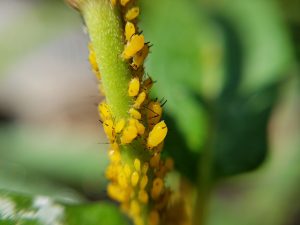
Aphids feeding on a plant stem.
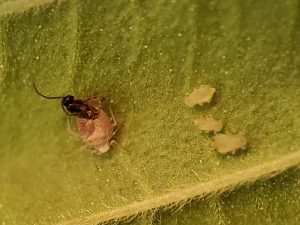
A parasitic wasp emerging from a dead aphid.
Aphids – Found on a wide variety of plants, aphids are fat-bodied little insects that often focus on new, tender growth. Their color depends on the plant they’re feeding on, and they can breed explosively. A female aphid does not need to mate to produce offspring, so a one can produce a lot of children very quickly. Look closely and you might be able to see their cornicles, which look like little tailpipes; these can help identify these pests. Luckily, we have some help in controlling aphids, as they are often parasitized by wasps. If you see large, swollen, brown aphids present, you probably have some wasps working for you.
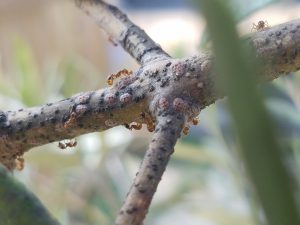
Ants tending some scale insects on a stem.
Scale Insects – Sometimes appearing to just be a bump on a stem or leaf, scale insects don’t move once they pick a plant to live on. Prolific producers of honeydew, some species grow a waxy shell which can protect them and make them difficult to deal with.
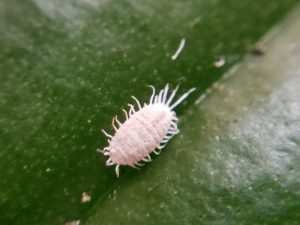
A mealybug.
Mealybugs – If you spy something white and fluffy living on stems or leaves, you might have mealybugs. Soft-bodied insects that are related to scales, they don’t move much. They feed on a wide range of host plants, but can effectively be controlled with a variety of methods once they’re found.
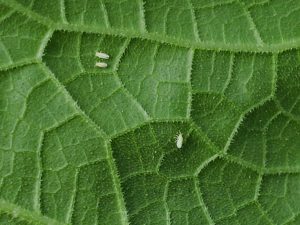
Whiteflies on the underside of a leaf.
Whiteflies – Not true flies, they are truly white in color. Tiny little members of the order Hemiptera (the same order that includes, aphids, scales, and mealybugs), they hang around the undersides of leaves. They enjoy warm weather and can become a problem in greenhouses. They are a bit more difficult to control than some of the other pests listed here.
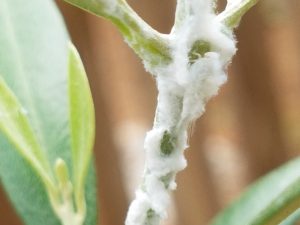
A psyllid nymph hiding in its waxy coating.
Psyllids and planthoppers – Small jumping insects that affect a variety of plant species, some are responsible for transmitting important plant diseases. Pierce’s disease of grapes and citrus greening, for example, are both vectored by these critters. Young nymphs sometimes secrete a waxy coating which may make them look similar to mealybugs.
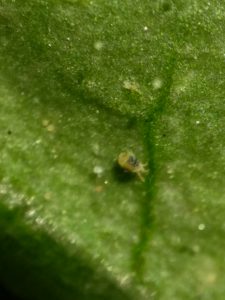
A tiny two-spotted spider mite.
Spider Mites – Not an insect but an arachnid, spider mites love hot, dry weather. Almost microscopic in size, the damage they do to leaves is often the first sign that they are present. Looking closely, one might notice tiny webbing where the mites live, or even the mites themselves on the undersides of leaves and on stems.
Many of these pests can be treated with a combination of methods. A sharp jet of water can dislodge some, hand removal can reduce populations even more, and products such as insecticidal soap or horticultural oils can finish them off. Insecticidal soaps are best used on soft-bodied insects such as aphids or mealybugs, while oils such as neem can help suffocate hard scales. Use products such as horticultural oil in the evening during hot weather to avoid damaging plant tissues with intense sunlight. Thorough coverage is important, as these products only control the pests they contact.
For more information on controlling insects, see our EDIS publications, such as Insect Management in the Home Garden or Landscape Integrated Pest Management.
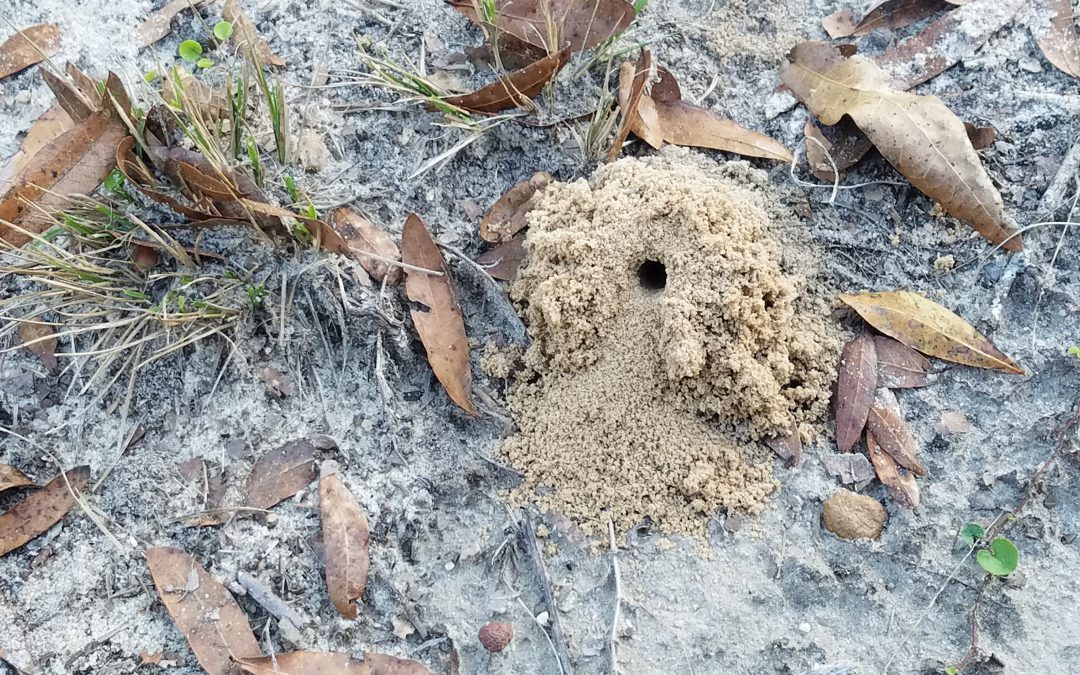
by Evan Anderson | May 20, 2021
Lawns and landscapes are greening up this time of year, and it’s not just plants showing signs of activity. All sorts of creatures are out there living their lives, and some of them are doing some digging.
From little piles of dirt to big mounds and long tunnels, it can be frustrating to figure out what is disrupting your carefully tended lawn or ornamental bed. Luckily, there are differences between the possible culprits. Here are some of the possibilities (see the associated links for more information and control methods):
-
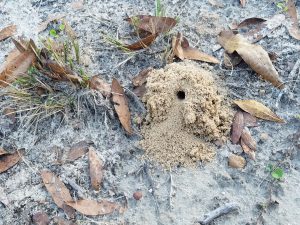
A miner bee hole. Photo: Evan Anderson
Miner Bees (and other ground nesting bees and insects) – Miner bees are harmless, solitary bees that tunnel into the soil. Not to be mistaken for yellowjackets, each bee digs her own small nest to lay her eggs in. Multiple such bees may be attracted to the same location, but they do not form hives and aren’t aggressive. Small mounds of soil may form around the entrances to their nests, but these will vanish after a rain.
- Moles – Small mammals (not rodents) that produce raised tunnels along the surface of the ground. They forage for insects among the roots of plants, and while their presence does have some benefits, many homeowners dislike their aesthetic contributions to the landscape. If you can overlook their tunnels, they do help aerate soil and eat pests like mole crickets, grubs, ant larvae, caterpillars, and slugs.
- Pocket Gophers – Sometimes called “sandymounders” or “salamanders” by old-timers, these are small rodents that dig tunnels beneath the ground. Active especially in cooler months, they make a series of mounds of soil in a line along their tunnel as they excavate. They feed on roots, bulbs, and tubers, though their sand-mounding is often more a problem than their feeding.
-
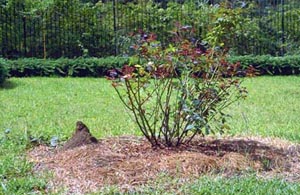
A fire ant mound in the landscape. Photo: B. Drees
Fire Ants – A single ant isn’t particularly threatening, but fire ants have found that thousands of rage-filled friends make a good deterrent. They build large mounds of soil to help regulate temperature and moisture in their nests, which can be quite unsightly in the landscape. Disturbing these mounds will unleash hordes of stinging ants, so beware; while they don’t necessarily do any harm to plants, they aren’t terribly friendly neighbors.
- Squirrels -These tree-dwelling rodents may nest up in the boughs, but often come down to the ground to look for food. In doing so, they may dig small holes as they forage for nuts, seeds, and fungi. The holes they dig are typically shallow and usually not too much of a problem.
- Armadillos – Nocturnal and heavily armored, the armadillo forages for insects in the ground. While it may sound beneficial to have an animal removing all the pest insects around, they aren’t careful about the damage they do while they feed. A hungry armadillo can dig numerous 3-5 inch wide, 1-3 inch deep holes in a lawn overnight, and may also burrow under structures, driveways, and patios.
- Yellowjackets – Yellowjackets are a bit of an honorable mention for this list, due to the fact that their digging often goes unseen. These ground-dwelling hornets leave no mounds or raised tunnels to identify their nests by. Instead, a small hole is often the only indication they are present, until a person or pet disturbs them. Then…surprise! It’s time for stinging, screaming, and crying.
For animal pests, the Florida Fish and Wildlife Conservation Commission maintains a list of nuisance wildlife trappers at https://public.myfwc.com/HGM/NWT/NWTSearch.aspx. For insects, you may need to contact a local pest control specialist or company. For help in identifying a problem, contact your local Extension office.
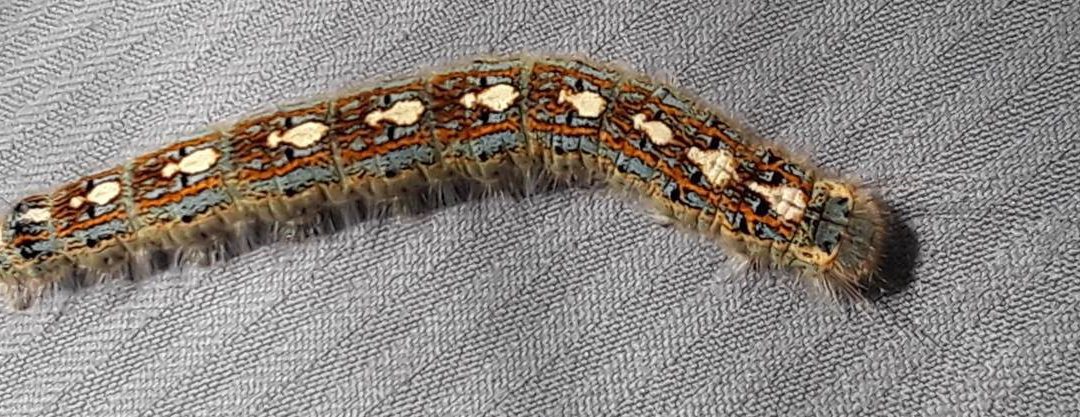
by Evan Anderson | May 20, 2021
A number of landowners in our region have been noticing a number of caterpillars coming down from the treetops. Sometimes appearing in vast numbers, the forest tent caterpillar has been found throughout Florida and the United States. Several years of heavy infestation occurred in Central Florida more than a decade ago, but populations are usually not high enough to cause significant damage to trees.
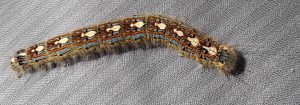
A forest tent caterpillar. – Photo courtesy of Shoal Sanctuary Nature Preserve.
The forest tent caterpillar is the larval stage of a somewhat nondescript brown moth. The moths lay their egg masses on twigs, and the eggs hatch in the spring. Caterpillars feed on a variety of tree species, but seem to prefer oak and gum trees. They spend anywhere from two to six weeks eating. When they are nearing maturity, they can become a problem for humans who do not appreciate the many droppings they produce, or their habit of descending from the trees to find places to spin their cocoons. They are sometimes attracted to lights or the walls of buildings, where they congregate in search of a place to pupate. They are not harmful to people, however.
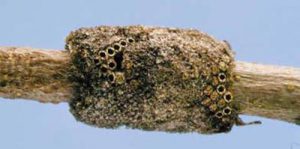
A forest tent caterpillar egg mass. – Photo courtesy of Jeffrey Lotz, Division of Plant Industry
Particularly cold winters may help decrease populations of these caterpillars. Inclement weather or high temperatures may do the same in the summer, and natural predators often help to control populations when present as well. Controlling forest tent caterpillars is most often unnecessary even when there are large numbers of them. It may help to avoid parking cars under large infestations or to turn off outdoor lighting that might attract them at night. If they wander indoors, check screens and window seals to be sure there are no gaps for them to enter.
If these or other caterpillars become such a nuisance that control measures must be considered, consider using a product such as Bacillus thuringiensis, or Bt, which specifically affects caterpillars and not other beneficial insects. Keep affected trees healthy with proper fertilization and watering, and even a defoliated tree will probably recover from any damage these insects cause. For more information, see our EDIS publication on the Forest Tent Caterpillar or contact your local Extension office.
-Evan Anderson, Walton County Horticulture Agent.
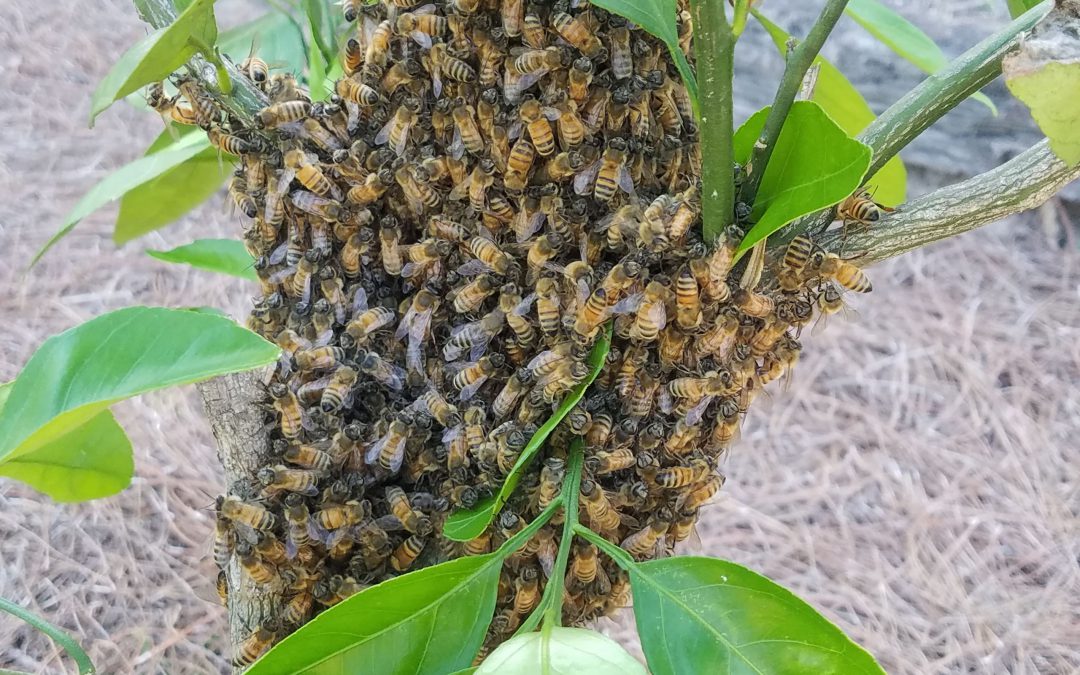
by Evan Anderson | Feb 25, 2021
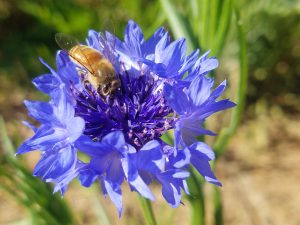
A worker bee gathering nectar and pollen.
As the weather warms, it seems that all kinds of living things start stirring. From birds to bees, plants to ants, and gnats to tourists, the world comes alive in the spring. It’s those bees we’ll discuss here, because every year they swarm, and that can cause some consternation among the homeowners whose houses they invade.
Honeybees are vitally important to our wellbeing, as they act as pollinators for many of our crops. They supply us with honey and wax and are a source of livelihood for many individuals. Important though they may be, they can sometimes become a nuisance.
Honeybees are eusocial organisms. Each honeybee lives in a colony or hive that it cannot survive without. In fact, it can be helpful to think of the entire hive as a single organism, even if it is made up of many individuals. The queen bee is the only one who lays eggs, but she cannot forage for her own food. Workers supply pollen and nectar to the hive but cannot reproduce on their own. Drones, or male bees, exist only to mate and would quickly die without the support of their sisters.
When a queen reproduces, she lays eggs that develop into new workers. When the time is right, she may lay eggs that develop into drones, or new females may be fed a substance called royal jelly that causes them to develop into new queens. These new drones and queens are born in preparation for a new hive to be created rather than to add more bees to the existing one. The old queen will be the adventurous one, so the workers put her on a diet. Once she has lost weight (to make it easier for her to fly), she takes half the workers in the hive and goes out in search of a new place to live. One of the new queens, after mating, returns to the nest and prepares to continue the work of her predecessor.
When the old queen leaves with her coterie, this is called a swarm. When weather warms and nectar begins to flow, the
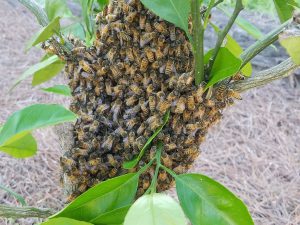
A swarm of bees looking for a new home.
bees travel from place to place looking for a good spot to live. Hollow cavities in trees are a favorite spot, but bee scouts often find what they think are perfect living places in our homes or sheds. While they are searching for a new place to set up shop, they may rest on trees or branches in large clumps. Do not be alarmed if you see one, as it does not mean they are nesting where they’ve stopped. Wait a while to see if they leave on their own or contact a local beekeeper to see if they want to collect the swarm.
If bees have taken up residence somewhere they’re not welcome, there are companies and individuals who may be able to collect the bees rather than destroying them. If removal is not an option, nuisance bees may be eradicated under Florida law, but this must be done by a certified Pest Control Operator.
If you have a swarm or hive on your property, check with the Department of Agriculture (Bee Removal or Eradication in Florida Resources) to find information and for a list of bee removal specialists. See our EDIS publication on choosing a pest control operator at Choosing the Right Pest Control Operator for Honey Bee Removal: A Consumer Guide. You can also contact your local Extension office for help with finding someone local.
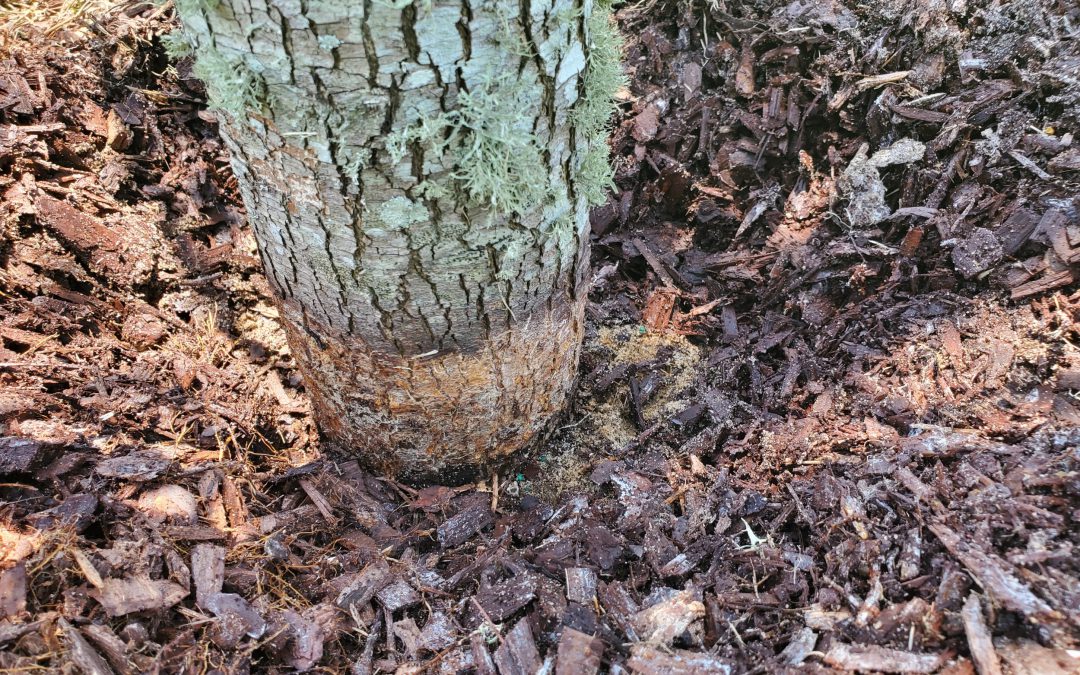
by Evan Anderson | Dec 16, 2020
Plants need water. This isn’t an outrageous insight, but the details behind this statement can be more complicated than it might seem. While it is true that plants, like all living things, need water to survive, they don’t all need the same amount and they may need more or less at different times. For a healthy landscape, garden, container planting, or lawn, it’s important to pay attention to the little quirks of watering that may not be immediately obvious.
During the wintertime, temperatures are lower and days are shorter. Less heat and sunlight means water will evaporate much more slowly and the soil will stay wetter. With less heat and sunlight, plants grow at a much slower rate (if at all). This means that irrigation systems set for summertime watering are probably going to keep conditions too damp for many plants during the winter. For example, a St. Augustinegrass lawn might only be able to survive 1 to 5 days without irrigation or rain in the summer, but the same lawn can last 8 to 28 days between waterings in the winter. Consider adjusting your irrigation system or watering schedule to account for seasonal differences. Remember also that a practiced eye can tell when a lawn needs water – folding or curled blades of grass, a dulling of color from bright green to bluish-gray, and footprints that remain in turf rather than springing back are signs of drought stress. Before these signs show up, it may not be necessary or beneficial to water.
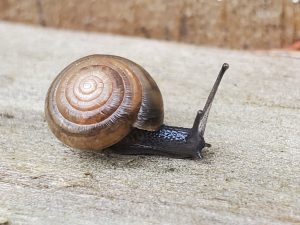
Snails love moisture, and an abundance of them may be a sign of too much irrigation.
If plants are overwatered, they often show different signs of distress. Lawns may have more issues with fungal diseases or become patchy, which can let weeds begin to take over. Ornamental plants such as shrubs and trees might show signs of nutrient deficiency or begin to drop leaves, appearing sparse and unhealthy. You may notice an increase in moisture-loving pests as well, such as slugs or snails. Check for watering issues if you notice any of these symptoms.
Cooler weather can be a good time to get outside and do regular maintenance on irrigation systems and plantings. Replace or unclog malfunctioning nozzles, patch
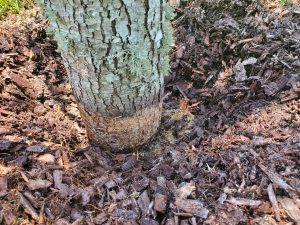
Moisture held against the base of a tree by mulch can eventually damage the plant.
holes in water lines, and adjust irrigation heads that may no longer be pointed in the right direction. Prune back plants that have grown into irrigation sprinkler patterns and may disrupt even watering. Put in new or replacement plants and make any adjustments needed to their irrigation. Lastly, add mulch around plants. This can help retain soil moisture, even out changes in soil temperature, suppress weed growth, and add organic matter to the soil as mulch breaks down. Avoid piling mulch against the base of plants, however, or it will hold moisture against the plant and can promote the growth of molds and other fungi.
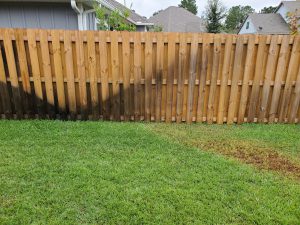
Improperly placed or calibrated sprinklers can cause problems.
For more information on watering, there is a wealth of knowledge online. The Florida Friendly Landscaping program has a lot to read on the topic: https://ffl.ifas.ufl.edu/handbook/Water_Efficiently_vSept09.pdf
The University of Florida EDIS publications cover many watering topics as well: https://edis.ifas.ufl.edu/topic_landscape_irrigation
And, as always, contact your local extension office for help as well!






















